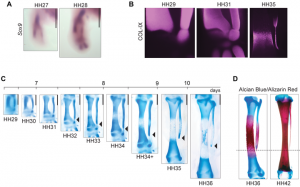
Scientists in Chile have created a chicken embryo that developed dinosaur-like feet after genetic manipulation, highlighting the evolutionary link between theropod dinosaurs and birds.
The research—published last week in the journal Evolution—shows that “by inhibiting early maturation of a leg of the chicken embryo, the leg reverts to the shape that dinosaurs’ legs had,” said Alexander Vargas, one of the six researchers at the University of Chile.
“The result is a chicken embryo with dinosaur legs,” Vargas told AFP on Tuesday, explaining what amounts to reverse evolution.
Theropods, a group of dinosaurs, started as carnivores but evolved to eat plants and insects.
Birds evolved from small theropods in the Jurassic period more than 145 million years ago.
In their study, scientists manipulated the Indian Hedgehog Homolog gene common to all animals, including man.
They were trying to pinpoint when birds had a dinosaur-like fibula bone. When the researchers delayed early development, the bone took on the tubular shape it once had in dinosaurs.
The research should help shed new light not just on the links between birds and dinosaurs, but on the genetic changes involved in the evolution, Vargas said.
It also confirmed the hypothesis that a bone can be made to regrow with characteristics from the evolutionary past by interfering with early maturation, according to the study led by Brazilian Joao Botelho at the University of Chile.

Reference:
João Francisco Botelho et al. Molecular development of fibular reduction in birds and its evolution from dinosaurs, Evolution (2016). DOI: 10.1111/evo.12882
Note: The above post is reprinted from materials provided by AFP.










